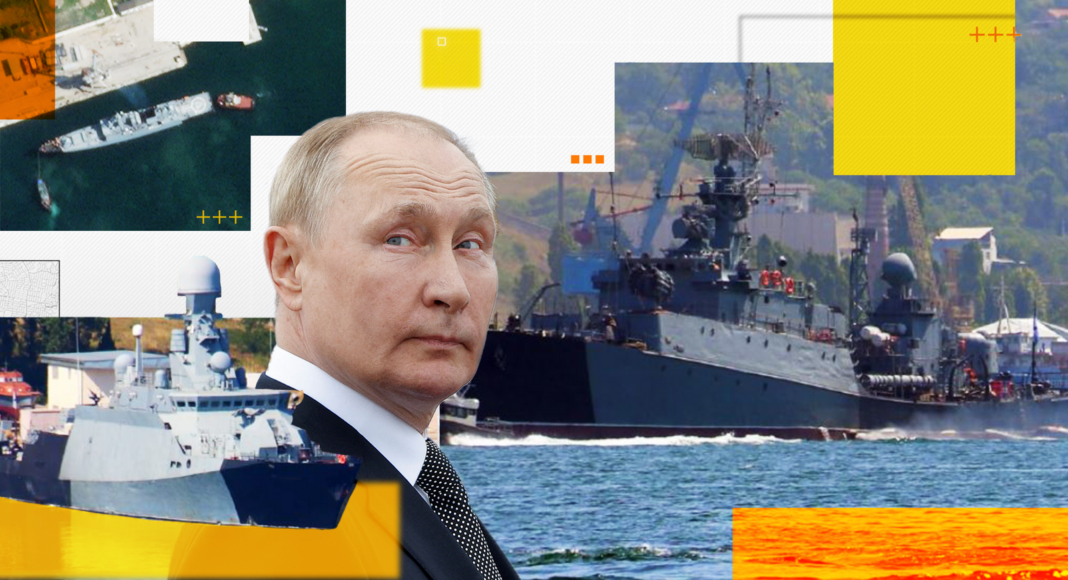Russia’s Black Sea Fleet was once considered mighty but with a growing threat from Ukrainian attacks, Moscow has turned to a First World War strategy to protect it.
Despite not having a navy itself, Ukraine has managed to carry out a series of successful attacks including strikes on Russia’s Black Sea navy HQ in Sevastopol in September and its 612ft flagship Moskva last April.
Sky News has found Russia has painted five of the fleet’s ships including its flagship Admiral Makarov over the past two months in what analysts describe as an attempt to protect the “vulnerable” fleet.
The Black Sea Fleet (BSF) has around 30 warships and is primarily based in Sevastopol in occupied Crimea.
Image:
The flagship Admiral Makarov. Pic: A. Brichevsky
We found the bow and stern of five warships including the Admiral Makarov – which became the fleet’s flagship after the sinking of the Moskva – were painted navy blue or black between 26 May and 4 July this year.
Experts suggest the painting of Makarov, its sister ship Admiral Essen, Ivan Gobulets, Muromets and Grayvoron aims to visually distract Ukrainian threats including sea drones, and to make the vessels appear smaller.
1:30
Why is Russia painting its Black Sea Fleet black?
Ukraine has boasted about its use of sea drones – the unmanned nimble vessels that carry explosives and travel on the surface of the water – which have been used in attacks in Crimea.
Read more – war latest:Russia ‘may target civilian ships with mines’
We compared archive images of the five ships and more recent pictures posted on a Russian Telegram channel linked to KCHF.ru – the fleet’s website.
We’re unable to prove the exact date that these boats were painted but based our timeline on the dates the images were posted online.
Open-source researchers previously pointed out that the painted Admiral Essen can also be seen in satellite imagery. The ship contains an 8 Kalibr land missile – which has been regularly used against Ukraine during the war.
Analysts say this is a “new form of dazzle painting” – a decoy technique using irregular patterns and colours, which was first used in the First World War to help offer protection from German boats at sea.
Image:
Before and after images of two of the painted ships Admiral Makarov (top) and Ivan Gobulets (bottom). Pics: A. Brichevsky
Analysts say painting either side of the boat attempts to present it as smaller than it is – hiding key features like helipads.
While naval decoy is not new, it does tell us something about the threat Ukraine is posing.
Defence and security analyst Professor Michael Clarke said: “It’s sensible idea, but Russia didn’t think its fleet would be in that position. They’re having to go back to some old traditional methods.
“I didn’t think the BSF would be under so much pressure. The fact the Ukrainians have made it vulnerable, we didn’t expect it at the start of the war.”
He adds that it’s a cheap tactic and can buy Russian forces extra time to shoot down incoming missiles if drones fall for the visual distraction, but it has “declining effectiveness”.
Image:
The painted bow of the Admiral Essen taken on 19th June in Sevastopol. Pic: Planet Labs PBC
Ukraine has access to drones that use radar signature and infrared signals so in some cases, a coat of paint won’t make a difference to detection.
Painting planes on tarmac
But Russia hasn’t stopped at naval camouflage – it’s also used the decoy technique to try to protect its airbases – even ones close to Moscow.
Satellite imagery previously highlighted by open-source researchers has shown that Russia has painted several aircraft on the ground at airbases to try to trick Ukrainian drones.
Images taken at Engels and Yeysk airbases and an S400 missile launcher base over the past few months show aircraft including Tu-95 strategic bombers painted onto the tarmac.
The S400 base in the Timiryazevsky District is only roughly 10km from the heart of Moscow.
Image:
Satellite image shows tyres on planes at Engles airbase on 28 August. Pic: Maxar Technologies
Raphael S. Cohen, Director of Strategy & Doctrine Program, Project Air Force at RAND said: “The war is coming closer to home for Russia. The fact that it merits a Russian response shows you should view this as a measure of effectiveness for the Ukrainians.
“If you’re causing the Russians to worry about their base defences such that they’re taking the time to camouflage, then you’ve clearly thrown them off balance.”
Satellite images have also shown tyres placed on the top of aircraft at Engels airbase which analysts suggest may be used to prevent damage to the aircraft from nearby explosions.
The Data and Forensics team is a multi-skilled unit dedicated to proing transparent journalism from Sky News. We gather, analyse and visualise data to tell data-driven stories. We combine traditional reporting skills with advanced analysis of satellite images, social media and other open source information. Through multimedia storytelling we aim to better explain the world while also showing how our journalism is done.




